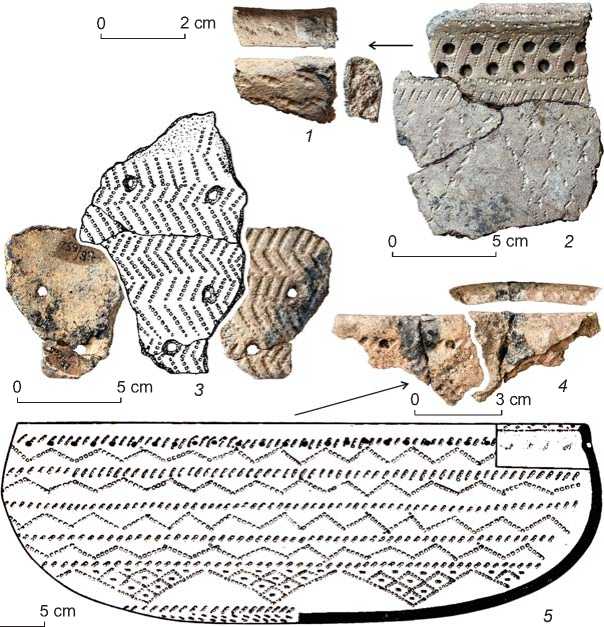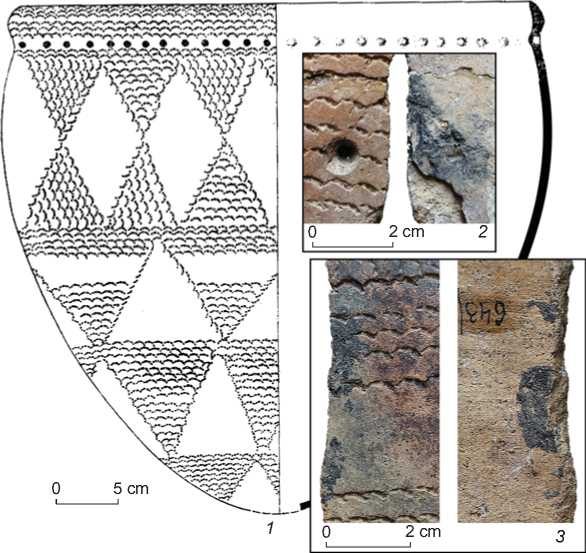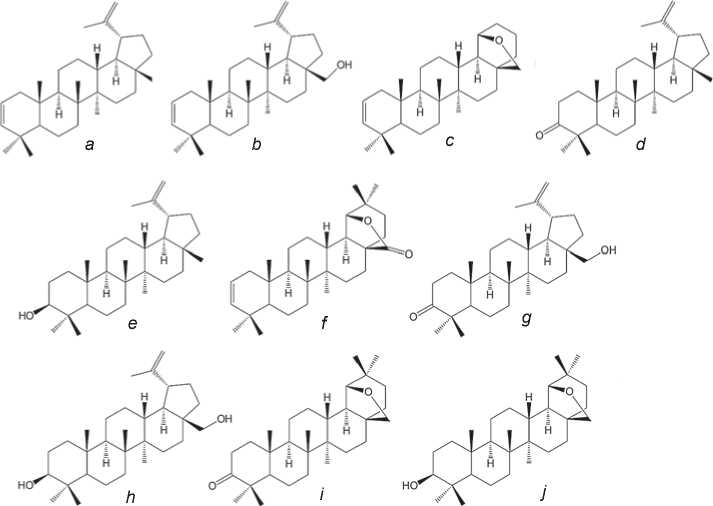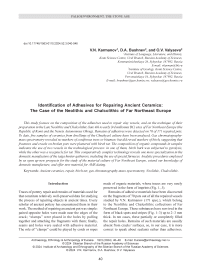Identification of adhesives for repairing ancient ceramics: the case of the Neolithic and Chalcolithic of far northeast Europe
Автор: Karmanov V.N., Bushnev D.A., Valyaeva O.V.
Журнал: Archaeology, Ethnology & Anthropology of Eurasia @journal-aeae-en
Рубрика: Paleoenvironment, the stone age
Статья в выпуске: 3 т.52, 2024 года.
Бесплатный доступ
This study focuses on the composition of the adhesives used to repair clay vessels, and on the technique of their preparation in the Late Neolithic and Chalcolithic (late 4th to early 3rd millennia BC) sites of Far Northeast Europe (the Republic of Komi and the Nenets Autonomous Okrug). Remains of adhesives were detected on 70 of 171 repaired pots. To date, five samples of ceramics from dwellings of the Chuzhyael culture have been analyzed. Gas chromatography-mass spectrometry revealed no markers of coniferous trees or bitumen; but did reveal markers of birch, suggesting that fractures and cracks on broken pots were plastered with birch tar. The composition of organic compounds in samples indicates the use of two vessels in the technological process: in one of them, birch bark was subjected to pyrolysis, while the other was a receptacle for tar. This comparatively complex technology reveals one more specialization in the domestic manufacture of the taiga hunter-gatherers, including the use of special furnaces. Analytic procedures employed by us open up new prospects for the study of the material culture of Far Northeast Europe, extend our knowledge of domestic manufacture, and offer new material for AMS dating.
Короткий адрес: https://sciup.org/145147215
IDR: 145147215 | DOI: 10.17746/1563-0110.2024.52.3.040-046
Текст научной статьи Identification of adhesives for repairing ancient ceramics: the case of the Neolithic and Chalcolithic of far northeast Europe
Traces of pottery repair and remains of materials used for that constitute relatively well-preserved data for studying the process of repairing objects in ancient times. Every scholar of ancient pottery has encountered them in their work. The method of repairing an ancient pot was simple: paired opposite holes were made near the edges of the crack; “clamps” were placed in the holes by pulling together and attaching the fragments with them; finally, seams and holes were sealed with adhesive material. The role of “clamps” could be played by cords or ropes made of organic materials, whose traces are very rarely preserved in the form of imprints (Fig. 1, 3).
Remains of adhesive materials have been discovered on the fragments of 70 pots out of all the repaired vessels studied by V.N. Karmanov (171 spec.), which belong to the Neolithic and Chalcolithic collections of Far Northeast Europe. These substances have survived in the form of black spots and stripes (Fig. 1–3) up to 2–3 mm thick. In ten cases, these partially or completely filled the repair holes. Remains of such materials are usually absent from cracks’ surfaces, so, in our case, it is more correct to speak about sealants rather than adhesives.

Fig. 1 . Photograph and drawing of pottery ( 1–4 ), graphic reconstruction of vessel ( 5 ).
1 , 2 – Muchkas, dwelling 8; 3 – Oshchoy I, dwelling 6 (Stokolos, 1986: Fig. 57, 7 ); 4 , 5 – Oshchoy V, dwelling 3 (Ibid.: Fig. 78).

Fig. 2 . Graphic reconstruction of vessel (Stokolos, 1986: Fig. 37) ( 1 ); photographs of vessel fragments from the outer and inner sides, with an imprint of a “clamp” made of untwined plant (?) fiber ( 2 , 3 ). Chuzhyael I, dwelling 5.1.

Fig. 3 . Graphic reconstruction of vessel (Stokolos, 1986: Fig. 31) ( 1 ), photographs of its surface parts ( 2 , 3 ). Chuzhyael I, dwelling 4.
The use of sealants distinguishes the repair of vessels from other applications of adhesive materials, such as attaching inserts into the grooves of composite tools or attaching arrowheads to shafts.
Conclusions about the preferences in applying the sealant to the inner or outer surface of a vessel are only tentative, since these depend on the preservation of the pottery. and are based on visual inspection without a microscope. Remains of adhesive have survived on 21 fragments on both surfaces, on 31 fragments on the outer surface, and on 18 fragments on the inner surface.
This study is the first step in the instrumental research on adhesives and their manufacturing technology applied to pottery repair by the ancient population of Far Northeast Europe. The work intends to establish the composition of sealants and their production technology, using gas chromatography-mass spectrometry.
Study history
Russian-language scholarly publications include only a few specialized works discussing the pottery repair of vessels of the Sintashta culture and contemporaneous sites in the steppe zone of the Urals and Northern Kazakhstan (Gutkov, 2000; Gavrish, 2018), and in the Baikal region (Ivanova, Shergin, 2021). International scholars also mention insufficient knowledge about the processes associated with pottery repair (Miloglav, 2020: 120). Only one book summarizes and systematizes archaeological and ethnographic evidence on repairing pottery (Geiko, 2013).
Much more attention is paid to studying the remains of putty in the cracks on the vessels’ walls. Scholars are primarily interested in the composition of adhesive substances. They try to identify them on the basis of general ideas about what they might have been (see, e.g., (Dyakonov, 2012: 110)), sometimes using ethnographic evidence (Glushkov, 1996: 86), but more often using scientific methods (Charters et al., 1993; Pesonen, 1999; Deryugin et al., 2018; Connan et al., 2020; Chen et al., 2022). Depending on the results, they establish the age of birch tar or pine resin residues (Pesonen, 1999), or sources of natural bitumen (Deryugin et al., 2018).
The range of natural materials that could have been used for the production of adhesives was wide (for more details, see (Langejans et al., 2022)). The most common residues discovered in archaeological evidence included birch tar, pine resin
(Charrié-Duhaut et al., 2013; Helwig et al., 2014), and natural bitumen or asphalt (Boëda et al., 2008; Brown et al., 2014). These were used either alone or in combination with each other and with other additives, such as animal fat or beeswax (for the bibliography, see (Miloglav, 2020: 121; Chen et al., 2022: 227)). Very rarely, possibly owing to poor preservation, traces of cracks have been found that were sealed with clay (Pesonen, 1996: Fig. 2) or “liquid clay fabric, possibly with addition of organic matter, such as resin” (Lokhov, Rogovskoy, Dudarek, 2013: 122, fig. 4, 4 ).
Instrumental studies of materials from Far Northeast Europe aimed at detecting sealant residues have been carried out only once. An employee of the Institute of Geology of the Komi Branch of the USSR Academy of Sciences (now, the Institute of Geology of the Komi Science Centre of the Ural Branch of the Russian Academy of Sciences, Syktyvkar), V.F. Udot, using a luminescent-bitumen analysis, discovered residues of resinous bitumen of petroleum origin on a vessel from the settlement of Niremka I (Kosinskaya, 1987: 133). We used the gas chromatography-mass spectrometry method.
Material and methods
One hundred and seventy one pots with clear signs of repair were identified among the Neolithic and
Chalcolithic pottery discovered in the region, including 70 vessels with sealant residues. To determine the nature and manufacturing technology of this material that ensured impermeability, using gas chromatography-mass spectrometry, five samples of pottery from the reference complexes of the Chuzhyael archaeological culture were analyzed: two from dwellings 4 and 5 of the Chuzhyael I site (see Fig. 2, 3), from dwelling 6 of the Oshchoy I site (see Fig. 1, 3 ), from dwelling 3 of the Oshchoy V site (Stokolos, 1986: 7–91) (see Fig. 1, 4 , 5 ), and from dwelling 8 of the Muchkas site (Stokolos, 1995) (see Fig. 1, 1 , 2 ).
When selecting the evidence, it was taken into consideration that complexes of this culture are the most representative source for pottery study, including its repair. Out of 190 examined vessels, signs of repair have been found on the fragments of 61 vessels, and remains of adhesive materials on 38 pots. The complexes of the Chuzhyael culture are well studied and dated (Stokolos, 1986: 7–91; 1988: 25–47; 1997: 213–229; Karmanov, Kosinskaya, 2021; Karmanov, Zaretskaya, 2021), which makes it possible to verify radiocarbon determinations further. Sealant residues are a finite source and need to be studied gently, taking into account the development and improvement of methods for their study and possible verification of results obtained, as well as the need to reserve samples for dating.
Analytical studies were carried out in the “Geonauka” Center for Collective Use at the Institute of Geology of the Komi Science Centre of the Ural Branch of the Russian Academy of Sciences. Samples of substances that were scraped from pottery fragments and weighed 5–10 mg were placed in a 1.5 ml vial for gas-liquid chromatography, and extracted with benzene for 72 hours by infusion in the dark at room temperature. After removing the solvent by evaporation, the extract was exposed to 100 μl of N,O-bis(trimethylsilyl)trifluoroacetamide (BSTFA) and 5 μl of tetraethylacetate added as a catalyst. The temperature of derivatization was 80 °C; the time was 1 hour. One ml of benzene was added to the solution as a solvent for analyzing TMS derivatives of the extract components.
Chromatography-mass spectrometry was carried out using a Shimadzu 2010 Ultra unit. Column HP-5, 30 m × 0.25 mm, with 0.10 μm thickness of stationary phase layer, temperature from 110 to 300 °C, and rate 5 °C/min was used. Injector temperature was 300 °C; detector temperature was 250 °C. The signal was recorded in the full spectrum scanning mode (SCAN).
Terpenoid derivatives were identified on the basis of the published mass spectra and data on the retention order of the components (Organic Mass Spectrometry…, 2009; Aveling, Heron, 1998; Binder et al., 1990; Regert, 2004; Charters et al., 1993; Rageot et al., 2019, 2021). The composition of carboxylic acids of the extract from the studied samples was determined using the NIST Mass Spectral Library.
Study results
Gas chromatography-mass spectrometry has shown that the qualitative composition of the studied samples was identical (Fig. 4). The following substances were confidently identified in it: betulin, betulone, allobetuline,

Time, min
Fig. 4 . Total ion current mass-chromatogram (TIC) of the BSTFA-derivatized adhesive extract of the sample from Muchkas, dwelling 8. 1–20 – peaks of TMS derivatives of carboxylic, dicarboxylic, and hydroxycarboxylic acids.
1 – octanedicarboxylic; 2 – nonanedicarboxylic; 3 – tetradecanoic; 4 – decadicarboxylic; 5 – pentadecanoic; 6 – undecanedicarboxylic; 7 – hexadecanoic (palmitic); 8 – heptadecanoic; 9 – octadecanoic (stearic); 10 – nonadecanoic; 11 – icosanoic; 12 – hexadecanedicarboxylic; 13 – heneicosanoic; 14 – cis-13-docosenoic; 15 – docosanoic; 16 – octadecanedicarboxylic; 17 – hydroxyicosanoic; 18 – icosanedicarboxylic; 19 – hydroxydocosanoic; 20 – docosanedicarboxylic. a–j – peaks of triterpenoids and their TMS derivatives: a – lupa-2,20(29)-diene; b – lupa-2,20(29)-diene-28-ol; c – allobetul-2-ene; d – lupenone; e – lupeol; f – 28-oxoallobetul-2-ene; g – betulone; h – botulin; i – 3-oxoallobetulane; j – allobetuline.

Fig. 5 . Peaks of triterpenoids and their TMS derivatives ( a–j ); structures of betulin ( h ) and lupeol ( e ), as well as their derivatives.
a – lupa-2,20(29)-diene; b – lupa-2,20(29)-diene-28-ol; c – allobetul-2-ene; d – lupenone; e – lupeol; f – 28-oxoallobetul-2-ene; g – betulone; h – betulin; i – 3-oxoallobetulan; j – allobetulin.
28-oxoallobetul-2-ene, 3-oxoallobetulane, allobetul-2-ene, lupeol, lupenone, lupa-2,20(29)-dien-28-ol, and lupa-2,20(29)-diene (Fig. 5), as well as dicarboxylic and hydroxycarboxylic acids. All these chemical compounds are either present in birch bark in their original form or are developed in the course of its thermal decomposition during production of birch tar. The biomarkers of coniferous trees (resin acids with diterpenoid structure) and traces of fossil bitumen were not found in the extracts studied.
Data on the composition of organic compounds— birch bark markers—indicate that the adhesive under study was made of birch tar. In addition, these markers make it possible to reconstruct the technology of its production. Previous studies have identified two main technologies for obtaining birch tar: “single-pot” and “double-pot” (Rageot et al., 2019: Fig. 2). In the former method, tar is not separated from the original birch bark and is subjected to more prolonged heating, since it is not removed from the hot zone. In the latter method, the resulting product flows down from the hot zone to colder zone, and therefore is not contaminated by original bark and is not subjected to secondary thermal transformation. From the chemical point of view, the products obtained by these methods show significant differences. The “single-pot” tar contains no dicarboxylic acids, but a relatively large number of markers of deep degradation/oxidation of the original birch bark biomarkers, which include allobetuline,
3-oxoallobetulane, 28-oxoallobetul-2-ene, and allobetul-2-ene (Rageot et al., 2019) (see Fig. 4).
In all the sealants studied, the main components are dicarboxylic acids of the C18-C22 composition, as well as birch bark biomarkers that did not undergo strong thermal degradation/oxidation. Markers of deep degradation/ oxidation are present in the extracts from the studied samples in insignificant concentrations (see Fig. 4, 5). This suggests that the studied substances were obtained by using the more sophisticated “double-pot” technique.
Discussion
Tar is a liquid product of pyrolysis—a process of heating substances to high temperatures, with limited air access. The most productive raw material in this case is birch bark, from which up to 14.3 % of tar can be extracted in laboratory conditions from the total mass of processed bark (Hayek et al., 1990: 2039). Methods of tar production are simple and were already known to the Neanderthals in the Middle Pleistocene (Kozowyk et al., 2017). The results of scientific experiments related to the reconstruction of ancient methods of obtaining tar have been published (see, e.g., (Ibid.)).
The identified signs of using the “double-pot” technique indicate another specialization of domestic manufacture in the Neolithic and Chalcolithic, which involved the use of a special heating device. No traces of such a furnace have yet been found in the examined dwellings. Possibly, tar production was located outside residential areas. Thus, along with devices for pottery firing, the remains of places for producing adhesives are another category of sources that “eludes” archaeologists. The design of the device has not yet been determined either. The question of how the finished product was accumulated also remains open: did it flow from the upper container into a vessel located below and deepened into the ground for cooling (Rageot et al., 2019: Fig. 4b), or was it taken out of the fire pit along a chute?
The results of the instrumental analysis of the adhesive composition open up new prospects for specialized interdisciplinary studies of the Neolithic and Chalcolithic of Far Northeast Europe, thanks to the high epistemic capacities of the studied category of records. For example, remains of sealants constitute promising evidence for direct AMS-dating of artifacts, which results are especially important in cases when it is impossible to determine the time of sources by independent methods. Traces of sealant were found on 70 vessels, which, given the use of wood resins and tar, is many times greater than the number of samples with organic crust—an imperfect material for dating.
Conclusions
This study has established that pottery from the referential sites of the Chuzhyael culture was repaired using birch tar. Tar was obtained in two vessels: one of these was used for pyrolysis of birch bark, and the other for the resulting product. So far, the study has identified the nature and technology of manufacturing a sealant for the repair of pottery belonging to the same tradition from the sites in the Mezen River valley. Research in this direction should be continued in order to identify the dynamics of using adhesives in space and time.
Acknowledgments
This study was carried out under the state assignment “Archaeological Sources: Description, Systematization and Critical Analysis (Based on the Evidence from the European Northeast of Russia)” and the state assignment of the Institute of Geology of the Komi Science Centre of the Ural Branch of the Russian Academy of Sciences.


